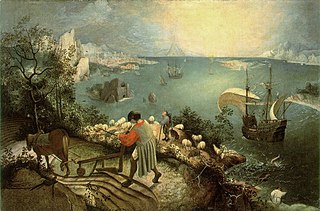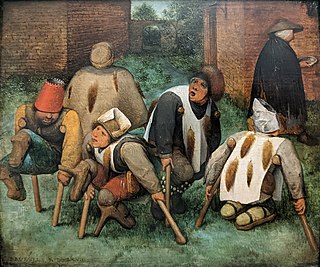| Number | Image | Game | Notes |
|---|
| 01 |  | Playing with dolls | |
| 02 | 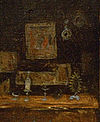 | Playing 'Holy Mass' | Small liturgical objects used at Mass and Liturgies |
| 03 |  | Water gun and owl on support | Shooting water at a bird |
| 04 |  | Wearing masks | Wearing disguises for fun |
| 05 |  | Swing ing from a hanging seat | The classic hanging seat |
| 06 |  | Climbing a fence | |
| 07 |  | Handstand | |
| 08 |  | Play the "knot" | Bending the body to contorted positions |
| 09 | 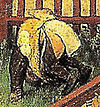 | Somersault | Flipping and rolling forwards, backwards, or sideways |
| 10 |  | Fence riding | Pretending the fence is a horse |
| 11 |  | Mock wedding | It is exactly at the diagonal centre of the panel. Perhaps an irony of the holy sacrament, or a reference to the main event that allows conception of children. Mock child weddings have been common folk tradition many places in Europe, and were often celebrated at Midsummer. |
| 12 |  | Passing through kicking legs - running the gauntlet | |
| 13 |  | Blind Man's Bluff | One player is blindfolded and then disoriented by being spun around. The other players call out to the "blind man" who attempts to tag them before they dodge away. |
| 14 | 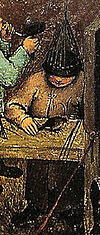 | Playing with birds | |
| 14b |  | Making hats with twigs | The child in the blue tunic is wearing a hat woven from twigs. |
| 15 | 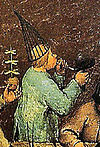 | Blowing bubbles | Still a popular pastime, Bruegel shows children blowing bubbles with clay pipes and verifies soap bubbles being used as entertainment for at least 400 years |
| 16 | 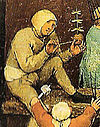 | Shell bobbin | A flying spinneret made of nut shells |
| 17 |  | Teetotum | Forerunner of the roulette and dice games |
| 17b | 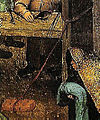 | Toy animal with leash | A stone dog of sorts |
| 18 |  | Knucklebones | Game of very ancient origin, played with five small objects, originally the "knucklebones" (actually the astragalus: a bone in the ankle, or hock) of a sheep, which are thrown up and caught in various ways; more commonly known as playing jacks. |
| 19 |  | Mock baptismal | Re-enacting the procession of adults carrying home a baby just baptized. The blue hood symbolises deception ("hooding the husband" meant to cuckold him, as shown in Bruegel's Netherlandish Proverbs ). |
| 20 |  | A hand game | Possibly the morra, a hand game - similar to rock, paper, scissors - that dates back thousands of years to ancient Roman and Greek times |
| 21 |  | Piñata | A papier-mâché or other type of container that is decorated, filled with toys and or candy and then broken, usually as part of a ceremony or celebration |
| 22 |  | Walk on stilts | Walking poles equipped with steps for the feet to stand on, they can be short (like here) or long (see number 62) |
| 23 |  | Play leapfrog | Vaulting over each other's stooped backs |
| 24 |  | Mock tournaments | Competitions of various kind |
| 25 |  | The "Pope's seat" | Holding the child by gripping hands |
| 26 |  | Hobby-horse | Riding a wooden hobby horse made of a straight stick with a small horse's head |
| 27 |  | Stirring excrement with a stick | |
| 28 | 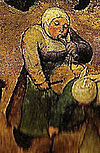 | Playing the flute and the drum | Playing simple music with basic instruments, always popular with kids |
| 29 |  | The simple roll hoop | Children and adults around the world have played with hoops, twirling, rolling and throwing them throughout history |
| 30 |  | Shouting into a barrel from a hole | The many uses of a barrel |
| 31 |  | The hoop with bells | A variation of rolling the hoop |
| 32 | 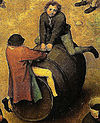 | Riding the barrel | With barrel vaulting, another popular play |
| 33 |  | Hat throwing | Throw them through a child's open legs, or see who throws farthest |
| 34 |  | Raisinbread man | A man-shaped loaf of bread, most likely some sort of Dutch duivekater, offered during wakes or at Christmas |
| 35 |  | The penalty of "bumbouncing" | Bouncing someone's buttocks on planks |
| 36 | 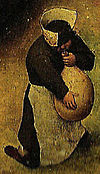 | Ball made with an inflated animal bladder | Inflating a bladder to create a balloon or ball |
| 37 | 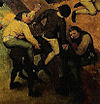 | Buck buck [7] | A group of children had to create a "pony" and another had to leap on their backs until the weight made it crumble |
| 38 |  | To play shop | On the wooden plank below the funnel Bruegel inscribed "BRUEGEL 1560" Red pigment was made from scraping bricks and was most famous from Antwerp. |
| 39 |  | Playing Tiddlywinks | Played with small discs called "winks", a pot, and a collection of squidgers. The children use a "squidger" (a disk) to propel a wink into flight by pressing down on a wink, thereby flicking it into the air: the objective of the game is to score points by sending one's own winks into the pot |
| 39b |  | Playing Mumblety-peg | An old outdoor game played by children using pocketknives |
| 40 |  | Building (a well) | |
| 41 |  | Pulling hair | May be a game or a fight |
| 42 |  | Catching insects with a net | |
| 43 |  | Playing the scourge | |
| 44 |  | Playing marbles | Ancient throwing game |
| 45 |  | Pitch and toss | The players each take a coin and take turns tossing them towards the wall: the coin the closest to the wall wins |
| 45b | 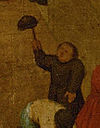 | Twirling a hat on a stick | |
| 46 | 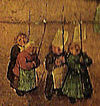 | Making a procession | Popular among children and adults, in diverse applications |
| 47 | 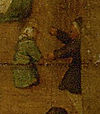 | Playing the porter | |
| 48 |  | Who's got the ball? | Hiding the ball and guessing who has it |
| 49 |  | Riding piggyback | Riding on another's shoulders |
| 50 |  | Singing door-to-door | |
| 51 |  | Bonfire | Lighting a fire |
| 52 |  | Riding a broom | A variation of hobby-horse, but with many players |
| 53 |  | Pushing a wall | |
| 54 |  | Hide-and-seek | Or "hide and go seek", a game in which a number of players conceal themselves in the environment, to be found by one or more seekers |
| 55 |  | The "devil's tail" or "crack the whip" | One player, chosen as the "head" of the tail or whip, runs around in random directions with subsequent players holding on to the hand of the previous player. The entire "tail" of the whip moves in those directions but with much more force toward the end of the tail. |
| 56 |  | Grappling | A basic form of wrestling |
| 57 |  | The "devil chained" | Role play as a street game |
| 58 | 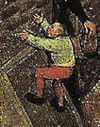 | Run, jump on a cellar's door | |
| 59 |  | Bowling | Players attempt to score points by rolling a ball along a flat surface, either into pins or to get close to a target ball |
| 60 |  | The token | Running and handing off the baton to the next runner |
| 61 |  | Throwing walnuts | Perhaps a variation of bowling or bocce, hitting an assembled cluster of nuts |
| 62 |  | High stilts | Walking on long poles |
| 63 |  | Pole vaulting | Exercising on a horizontally fixed bar |
| 64 |  | Balancing a stick on a finger | A clownish game of balance |
| 65 |  | Put up a show | Enacting a play |
| 66 |  | Spinning tops | Using toys that can be spun on an axis, balancing on a point |
| 67 |  | The trolleys | Baskets moving on a line |
| 68 |  | Flying a ribbon on a stick | Letting a piece of cloth fly in the wind from a stick |
| 69 |  | Whom shall I choose? | A girl selects her "baby" from a group of friends under a blanket |
| 70 |  | Urinating | |
| 71 |  | Bocce | In teams, throwing the bocce balls closest to the jack ball |
| 72 |  | Pirouetting skirts | Swirling the girls' skirts round and round |
| 73 |  | Climbing a tree | |
| 74 |  | Swimming | A healthy recreational exercise, enjoying a full-body workout |
| 75 |  | Diving | Jumping or falling into water is always fun for children |
| 76 |  | Floating with an inflated pig's bladder | A sheep's bladder was also used, to float on top of it or to play water games |
| 77 |  | "Dethroning the King" | A game also known as "king of the hill" |
| 78 |  | Playing with sand | Popular with children across the world |
| 79 |  | Coil tournament | A fight of knights |
| 80 |  | Rattles | Noisy musical game |






















































































